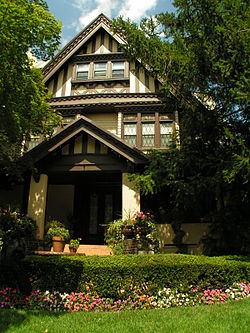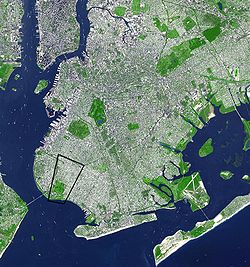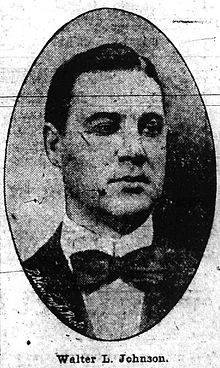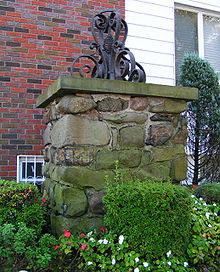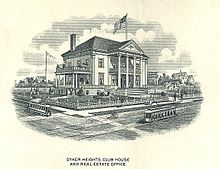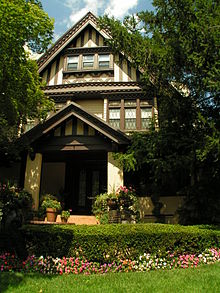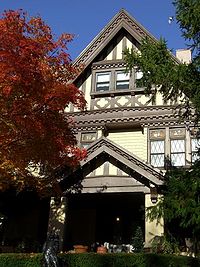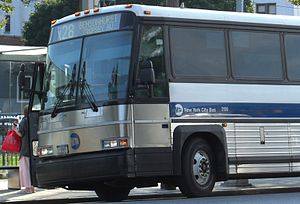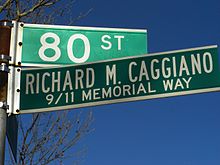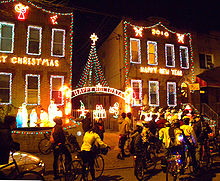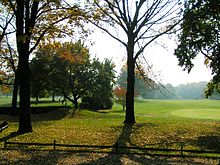- Dyker Heights, Brooklyn
-
Dyker Heights The Saitta House, an original Dyker Heights home Nickname(s): Dyker Motto: "The Handsomest Suburb in Greater New York" Dyker Heights as seen from space Coordinates: 40°37′N 74°01′W / 40.617°N 74.017°W Country United States State New York City New York City County Kings Borough Brooklyn Developed 1895-1902 Developer Walter L. Johnson Government - Mayor Michael Bloomberg (I) - Borough President Marty Markowitz (D) - State Senator Marty Golden (R) Elevation 110-51 ft (33.5-15.5 m) Population (Census 2000)[1] - Total 41,172 - Demonym New Yorker Time zone EST (UTC-5) - Summer (DST) EDT (UTC-4) ZIP code 11228 Area code(s) 718, 917, 347, 646 Website www.dykerheightscivicassociation.com Dyker Heights is a residential neighborhood in the southwest corner of the Borough of Brooklyn in New York City, USA. It is sandwiched among Bay Ridge, Bensonhurst, and Gravesend Bay. According to the Post Office, Dyker Heights is bounded to the west by Interstate 278, to the north by Bay Ridge Avenue, to the east by Fourteenth Avenue, and to the south by Fort Hamilton. The Dyker Beach Golf Course extends to the Belt Parkway. Dyker Heights originated as a speculative luxury housing development in October 1895 when Walter Loveridge Johnson developed a portion of woodland into a suburban community. During the height of his development, the boundaries were primarily between Tenth Avenue and Thirteenth Avenue and from 79th Street to 86th Street. The finest homes of the development were situated along the top of the 110-foot (34 m) hill, at about Eleventh Avenue and 82nd Street. Dyker Heights is patrolled by the 68th Precinct of the NYPD.[2]
History
New Utrecht Woodlands
The neighborhood of Dyker Heights lies within the boundaries of the original Dutch town of New Utrecht settled in 1657. The area that is now as Dyker Heights was not developed in the 17th or 18th centuries because the land was too sloped for farming. It remained common woodland until the mid-19th century. The trees of this forest were used by the townsfolk as a source of firewood and construction material. When the agricultural industry of New Utrecht changed from the farming of grains to the cultivation of market garden produce, the trees were cleared and the area became a large market garden with tomatoes, cabbages, and potatoes, among other produce.[3]

De Russy's Estate
The first house built at the top of the hill (what is now Eleventh Avenue and Eighty-Second Street, at about 110 feet (34 m) above sea level) was built in the late 1820s by Brigadier General René Edward De Russy of the United States Army. De Russy was a military engineer who built many forts in the United States – from the Canadian border and the eastern seaboard to the Gulf of Mexico and the Pacific coast – including Fort Hamilton in Brooklyn.[4] Since this is the tallest natural point in southwest Brooklyn, De Russy built his homestead here – it afforded a clear view of the harbor and its defenses, especially Fort Hamilton which was complete by November 1831. De Russy died in 1865 and his wife, Helen, sold the property in 1888 to Jane Elisabeth Loveridge and Frederick Henry Johnson.
Frederick H. Johnson's speculation
According to the Brooklyn Eagle, Frederick Johnson did "much toward developing the locality in which he resided. He was the author of the original New Utrecht Improvement Bill, and an ardent advocate of the annexation of the Town to this City."[5] The Town of New Utrecht was annexed to the City of Brooklyn on July 1, 1894. On January 1, 1898, the City of Brooklyn was annexed to the City of New York. Involved with real estate, Johnson was probably very aware of the real estate pressures on and potential of the real estate in New Utrecht. With this in mind, he most likely purchased the De Russy Estate with the intention of building an upscale residential neighborhood similar to Bensonhurst-by-the-Sea, built by James D. Lynch from 1880-1890 in the Bath Beach section of New Utrecht.[6] At that time, The Real Estate Record claimed Bensonhurst-by-the-Sea was "the most perfectly developed suburb ever laid out around New York."[7] The restrictions placed upon the property made Bensonhurst-by-the-Sea "a model settlement, where some of the most refined, intelligent and cultured of New York and Brooklyn's citizens have built their homes."[7]
Walter L. Johnson's vision
Following Frederick Johnson's death on August 15, 1893 at the age of 52, his second son, Walter Loveridge Johnson, took over the real estate business and by October 1895 Walter started Dyker Heights on his parents' property. Walter L. Johnson named his development "Dyker Heights" after the Dyker Meadow and Beach, which his development overlooks. The meadow and beach received their name from either the Van Dykes (an original New Utrecht family) who built the dykes to drain the meadow, or for the dykes that the Van Dykes built.[6]
Walter L. Johnson was able to develop this portion of New Utrecht woodland into a residential community by making necessary improvements to it. In 1890, the only roads present were Kings Highway, Eighty-Sixth Street, Denyse's Lane, and a small unnamed road near Tenth Avenue – none of which were paved and only Eighty-Sixth Street was a thoroughfare specifically planned as such. The remaining land was unimproved. Johnson continued Brooklyn's street grid south with macadam pavement, graded the properties, installed gas, water, telephone, and electricity lines, and planted sugar maple trees – seven on the avenues and twenty along the streets. This opened over two hundred more building sites between Tenth and Thirteenth avenues as well as between Seventy-Ninth Street and Eighty-Sixth Street.
The original three
In 1895, Johnson, very much aware of the successful Bensonhurst-by-the-Sea, built three homes. His home was on the southwest corner of Eleventh Avenue and Eighty-Second Street (across the Avenue from the home of his mother), Albert Edward Parfitt's home was on Eighty-Second Street next to Johnson's, and the last, closest to Tenth Avenue, was the home of Arthur S. Tuttle who was Assistant Engineer of The Water Supply of The City Works Department of The City of Brooklyn. Parfitt was the architect of these three homes. Johnson's house burned down before 1900, Parfitt's was demolished by a developer in 1928 and replaced with seven, run-of-the-mill, fully detached, single-family homes, and Tuttle's house was remodeled over 10 years ago and clad in bright-white and sky-blue brick.[6]
The praise from the print press
"The Handsomest Suburb in Greater New York"
Throughout the infancy of the development, Walter L. Johnson was able to use the print press to his advantage. He advertised his suburban homes heavily and stated that the high ground, magnificent ocean view, and careful restrictions made Dyker Heights the handsomest suburb in Greater New York. Based on the newspaper accounts, he was right. In 1896 Johnson built and sold thirty homes in Dyker Heights. By January 1897, the Brooklyn Eagle reported on his achievements. "Mr. Johnson has met with great success in the development of Dyker Heights and had probably done more business and made more sales during the past year than all the rest of the surrounding settlements combined."[8] In April 1898 sales were still very strong. "Dyker Heights still holds its lead among the suburban sections in building operations, over forty houses having been erected there during the past year... and there are fully twenty more houses about to be built."[9] One of its many advantages was the location, which according to the Brooklyn Eagle, "is one of the finest in Greater New York, commanding an extensive view of water from Sandy Hook to the New Jersey Palisades, with Staten Island and the shores of New Jersey directly in front."[10] Still more praise in February 1899, "Dyker Heights has been one of the most successful and the most rapid in growth of any of the suburban settlements, over one hundred dwellings, costing from $5,000 to $25,000 each, having been erected there within the last two years."[11]
"An ideal spot for a home"
In September 1899, the Wall Street Journal even reported on the advantages of the development, recommending it to "the busy man of Wall Street" because of "its magnificent transportation facilities... it can be reached via the Thirty-Ninth Street Brooklyn Ferry and Eighty-Sixth Street Nassau Line in 45 minutes."[12] In addition the article claimed that "the 45 minutes' trip between Dyker Heights and Wall Street by water and rail is as invigorating as the Dyker Heights climate is healthy-living. The rare opportunities afforded by Dyker Heights to the wealthy and to those in moderate circumstances are due largely to the energy, enterprise and good taste of its founder, Mr. Walter L. Johnson."[12] A month later, the Wall Street Journal published "An Ideal Spot for a Home." From that article, one can clearly see why Dyker Heights was so successful. Its location and luxurious homes were first rate, "[Dyker Heights] is without a rival as to location, situated as it is at an elevation of [110] feet above the sea level, and is directly opposite the new Dyker Meadow Park... which will be the only seaside park in Greater New York."[13] The article also explained the exclusiveness of the property, which can be seen in "its massive stone piers with heavy wrought-iron lamps and scrolls" that adorn the entrances.[13] In December 1899 the Brooklyn Eagle reported that, "work has recently been commenced upon thirty high class Houses, the demand for which runs a dead heat with the supply."[14]
"One of the most magnificent"
Johnson set very high standards for the community: the Wall Street Journal explained "the property is carefully restricted against all nuisances and no building can be erected upon a plot of less than 60 feet (18 m) in width by 100 feet (30 m) in depth, and each building must cost at least $4,000 and stand well back from the street."[13] These regulations, which were similar to those of Bensonhurst-by-the-Sea, were active until 1915. However, the most desirable feature of the area was still the "uninterrupted view of the lower bay from The Narrows to Sandy Hook and Atlantic Ocean, [which] is one of the most magnificent in the country, and nowhere else in the consolidated city is there anything to compare it with. From here can be seen a marine panorama hard to beat."[13] Dyker Heights was so desirous that important members of society flocked to it. The Brooklyn Eagle reported in December 1899 that this "drain" on the more established social neighborhoods such as Brooklyn Heights and those in Manhattan, "almost threatens to lower the social tone of the neighborhoods where this universal exodus is effecting a gradual change in the character of the population."[14]
First public kindergarten for the blind
Property on Eighty-fourth Street near Thirteenth Avenue was made available to the International Sunshine Society in 1906 by lawyer, financier, and promoter George E. Crater, Jr.[15] The society was able to acquire the house for $11,000, roughly half the market value, and opened the Dyker Heights Home for Blind Babies on 1 November 1906. Cynthia W. Alden, Mary C. Seward, and other society officers worked with the New York City Board of Education to establish the first public kindergarten for blind children at the home in 1907.[16] The original building is gone, but the work begun in Dyker Heights provided a legacy of significant reforms in the public education of blind children within New York and other regions of the United States.
The club house and real estate office
One of the many focal points of the neighborhood was the Dyker Heights Club, which started in October 1896.[6] By spring of 1898 the Club had a $30,000 club house designed by Albert Edward Parfitt on an $8,500 lot, measuring 200 × 200, located on the northeast corner of Thirteenth Avenue and Eighty-Sixth Street. Johnson moved his real estate office into the club house and hired a full-time architect, Constantine Schubert, who was also a Dyker Heights homeowner. This grand, neo-classical building was sadly demolished in 1929 by the Archbishop John Hughes Knights of Columbus Club, when they acquired the property for $60,000.[17]
Early in the history of Dyker Heights, Walter L. Johnson continually purchased consecutive tracts of land until the boundaries of Dyker Heights stretched from Seventy-Ninth Street in the north, roughly Eighty-Sixth Street in the south, Tenth Avenue to the west, and about 300 feet (90 m) east of Thirteenth Avenue to the east. However, the boundaries of the Neighborhood of Dyker Heights are now defined by the Dyker Heights Post Office on the northwest corner of 13th and 84th Streets; along its northeast edge runs Bay Ridge Avenue; Sixteenth Avenue is its southeast boundary; Fort Hamilton makes its southwest border; and Interstate 278 is the northwest limit.
Homes in Dyker Heights
Original homes
In December 1899, the Brooklyn Eagle wrote a very detailed description of the homes in Dyker Heights:
"The typical Dyker Heights residences have five rooms each on the first and second floors and four rooms on the third. Upon entrance, the inmate or visitor is ushered into a hall twelve feet wide which runs back to the butler’s pantry. To the right of this hall is the parlor and library and to the left the reception and dining rooms. The rear space is taken up by the kitchen, butler’s pantry and washrooms with tiled floors. Birdseye maple is used in the finishing of the parlor and quartered oak in that of the library, one with mantles of the same wood in fancy tile finish. A large fireplace with ornamental andirons completes the mural decoration. The ceilings are ten feet high on the first floor, while nine feet is the elevation of the second and eight feet that of the third floor. Usually the dining room is fifteen feet square and finished off in quartered sycamore. Like the hall, the reception room is done off in quartered oak, but is circular in form and has a diameter of ten feet. In the kitchen is a glazed fireplace, while below stairs, speaking from a first floor level, are the cellar and laundry, with a depth of eight feet, and an asphalt double concrete floor."[14]
"Of the five rooms on the second floor, one is a sitting room and the remainder sleeping apartments, all of which are finished in quartered oak and sycamore. A large bathroom with tiled floors takes up the remaining space of the second story. Rising to the third floor we find plain cypress as the invariable finish of the apartments, which comprise two servants’ rooms, a card or sitting room and a billiard parlor wainscoted on the sides and provided with seats for the players and onlookers. It may be noted further that the reception room and dining room are also wainscoted six feet high."[14]
Of the approximately 150 homes initially built by Walter L. Johnson, about half remain; while the others have been razed and replaced by large Mediterranean villas, condos, as well as semi and fully attached homes. Very few of the newer homes fit into the historic context of Dyker Heights, and many of the original surviving homes have been extensively renovated and remodeled.[18]
Some Original Homes of Dyker Heights Saitta House
Saitta House Side view of the Saitta House.
Side view of the Saitta House.Location: 1135 84th St., Brooklyn, New York Coordinates: 40°37′2″N 74°0′59″W / 40.61722°N 74.01639°WCoordinates: 40°37′2″N 74°0′59″W / 40.61722°N 74.01639°W Area: less than one acre Built: 1899 Architect: Petit, John J.; La Note, P.J. Architectural style: Queen Anne Governing body: Private NRHP Reference#: 07000480[19] Added to NRHP: May 30, 2007 The Saitta House is a two-and-a-half-story, one-family Queen Anne dwelling completed ca. 1899 by architect John J. Petit and builder P.J. la Note for Beatrice and Simone Saitta (pronounced: sigh-eat-a). The home is located on the north side of 84th Street between Twelfth Avenue to the east and Eleventh Avenue to the west. The home reportedly cost $14,000 to build and the 8,000 sq ft (700 m2) of land cost $2,700.[20]
The Saitta House is significant in the area of architecture as a remarkably intact, high-style example of Queen Anne residential architecture and for its association with the development and planning of Dyker Heights, a turn-of-the-20th-century suburban development in Brooklyn. No other house in Dyker Heights retains so much of its original architectural and structural components – both interior and exterior – as the Saitta House. The house was architect-designed for an affluent Dyker Heights family, and built ca. 1899 by craftsmen who came from Italy and lived on the premises during construction. Architect John J. Petit’s work can be found elsewhere in Brooklyn especially in the Prospect Park South Historic District (National Register listed). The Saitta House represents the original ideals, way of life, and quality architectural design of the original Dyker Heights development.[citation needed] It was listed on both the State and National Register of Historic Places in 2007.[6] In June 2007, many local newspapers reported this news.[21][22]
The Saitta House through the Seasons at Dyker Heights Demographics
As the 2000 Census, there were 41,172 people living in Dyker Heights. The demographics were 81.8% White, 0.3% Black or African American, 0.1% Native American, 12.6% Asian and 6.6% Hispanic or Latino. The five most common ancestries were Italian (69.0%), Chinese (10.7%), Irish (8.9%), Arab (4.2%) and Greek (3.9%).
Original residents
The original inhabitants of Dyker Heights were mainly of Anglican background; in fact they established Saint Phillip’s Episcopal Church, which still functions today. The residents were either local government officials or wealthy professionals. For instance, I. M. De Varona was Engineer of the Water Bureau, Clarence Barrow was Ex-Fire Commissioner, William C. Bryant was current Fire Commissioner, George W. Dickinson was a cotton-goods merchant, W. Bennett Wardell was a retired Judge, Richard Perry Chittenden was Assistant of the Corporation Counsel, Freeland Willcox was Secretary of the Cheeseborough Vaseline Company, and Eugene Boucher was longshoreman and insurance broker.[6]
Italian-American homeowners in Dyker Heights were originally small in number and included Dr. Lorenzo Ullo, Counselor to the General Company of Italian Navigation, and Simone Saitta, a Manhattan wholesale fruit dealer. However, Walter L. Johnson did not care much for Italians, especially poor Italians. The Brooklyn Eagle explained a problem Johnson had with a particular Italian family in Dyker Heights ". . . [The property] which at the time was owned by Walter L. Johnson, was occupied by an Italian family, to whom Mr. Johnson paid $600 to vacate it in order that the neighborhood of Dyker Heights, which is very carefully restricted, might have no objectionable features about it."[23] By 1940 Dyker Heights was inhabited by a majority of people of Italian descent many of whom helped establish the Roman Catholic Shrine Church of Saint Bernadette (ca. 1935) on 13th Avenue between 82nd and 83rd streets.
Notable residents
Notable current and former residents of Dyker Heights include:
- Joe Rollino – an original Old Coney Island Strongman, who died at the age of 104 on Monday January 11, 2010 at 6:45am after being hit by a car while he crossed Bay Ridge Parkway at 13th Avenue. Experts say that the "Great Joe Rollino," the "Mighty Joe Rollino," the "Kid Dundee" was "one of the strongest men who ever lived." He was longtime member of the Association of Oldetime Barbell and Strongmen and lived on 14th Avenue in the 70s.[24][25][26]
- Scott Baio – an actor famous for his work on such programs as Happy Days, Joanie Loves Chachi, Scott Baio is 46 and Pregnant, and Charles in Charge.[27]
- Rosanna Scotto – an Anchor on Fox 5 NewsWNYW for 25 years, grew up on 11th Avenue and 83rd Street.[28]
- Judge Angelo Mibanda - Former Second Circuit Court of Appeals Judge. Grew up on 14th Avenue and Freedom Road. [29]
Politics
U.S. Congress
- Michael Grimm - House of Representatives of New York’s 13th Congressional District. (MAP)[30]
State Senate
- Martin J. Golden - New York State Senate of New York’s 22nd Senatorial District. (MAP)[31]
City council
- Vincent J. Gentile – New York City Council of New York’s 43rd Council District.[32]
State assembly
- Alec Brook-Krasny – New York State Assembly of New York’s 46th Assembly District. (MAP)[33]
- Dov Hikind – New York State Assembly of New York’s 48th Assembly District. (MAP)[34]
- Peter Abbate – New York State Assembly of New York’s 49th Assembly District. (MAP)[35]
Local
- Brooklyn Community Board 10 (MAP)[36]
- Dyker Heights Civic Association[37]
Civic services
- Ambulance – BRAVO, the Bay Ridge Ambulance Volunteer Organization[38]
- Brooklyn Public Library – Dyker Heights Branch[39]
- FDNY – Engine Company 284, Ladder Company 149[40]
- NYPD – 68th Precinct[41]
- United States Post Office – Dyker Heights Branch[42]
Crime
According to the CompStat (COMPuter STATistics) database of the NYPD for the 68th Precinct, Dyker Heights is one of the safest neighborhoods in all of New York City, with an 86.23% reduction in all crimes since 1990.[43] Most notably, murder is down 90.9% since 1990 with 1 reported case in 2009 and 0 in 2008.[44][45] There were 6 reported cases of rape in 2009, consistent with a 62.5% drop since 1990. There were 115 robberies and 206 burglaries in 2009, down 83.9% and 87.8%, respectively, since 1990. Felony assault charges have decreased by 68.1% since 1990, with 79 cases in 2009. Grand larceny, having a total of 370 cases in 2009, and grand larcenies for automobiles (G.L.A), with 155 reports in 2009, have also dropped, 60.7% and 95.1% respectively.
Transportation
Subway
The center of Dyker Heights is not served by subway, but its neighboring communities are. Bay Ridge is served by the BMT Fourth Avenue Line (R train), with stations at Bay Ridge Avenue, 77th Street, 86th Street and 95th Street.[46] The far south end of Boro Park is served by the BMT Sea Beach Line (N train), with stations at Fort Hamilton Parkway and New Utrecht Avenue.[47] Bensonhurst is served by the BMT West End Line (D train), with stations at 79th Street, 71st Street and 62nd Street.[48]
Buses
Several local bus routes and one express route serve Dyker Heights:
- B64, which runs on 13th Avenue (Dyker Heights Boulevard) between 86th Street and Bay Ridge Avenue[49]
- B4, which services Bay Ridge Parkway[50]
- B16, running on Fort Hamilton Parkway[51]
- B1, which is on 86th Street[52]
- B70, serving Seventh and Eighth Avenues on the neighborhood's western edge[53]
- X28: to Manhattan via the Gowanus Expressway.[54]
Car
Dyker Heights is accessible by car via the Belt Parkway, Verrazano-Narrows Bridge to Staten Island, and Gowanus Expressway (Brooklyn-Queens Expressway).
Named streets
- Lieutenant William E. Coffey Square – 81st Street, between 7th Avenue and Fort Hamilton Parkway. In the square stands one flagpole and two upright granite stones. One stone contains a bronze plaque inscribed with “In Memory Of Those Members Of Our Armed Forces Who Gave Their Lives For Our Country These Dead Shall Not Have Died In Vain” and other stone has an incised scene of Iwo Jima.[55][56]
- Marie Walsh Corner – southwest corner of 84th Street and 7th Avenue. Marie Walsh was a dedicated community activist being a member of the Dyker Heights Civic Association, Bay Ridge Community Council, and the Kings County Conservative Party. She also helped to establish the X28 bus. On June 10, 1996 Mayor Rudolph W. Giuliani signed the bill into law.[57][58]
- Dyker Heights Boulevard – 13th Avenue, between 86th Street and Bay Ridge Avenue. On August 8, 2001 Mayor Rudolph W. Giuliani signed the bill into law.[59]
- Firefighter Dennis Patrick O'Berg 9/11 Memorial Way – 74th Street, between 10th and 11th Avenues. Although he graduated from the State University of New York at Geneseo with a degree in accounting, O’Berg followed in his father’s footsteps and became a firefighter. He was a member of Ladder 105, in the Prospect Heights section of Brooklyn. On October 20, 2003 Mayor Michael R. Bloomberg signed the bill into law.[60][61]
- Robert F. Tipaldi 9/11 Memorial Way – 80th Street, between 7th and 10th Avenues. Tipaldi was a 25-year-old generous and successful assistant trader with Cantor Fitzgerald on the 104th floor of World Trade Center Tower 1. On December 21, 2004 Mayor Michael R. Bloomberg signed the bill into law.[62][63]
- Maria LaVache 9/11 Memorial Way – 72nd Street between 11th and 12th Avenues. Maria worked, for many years as the receptionist for J&H's International Department but was transferred to another office on the 99th floor of the World Trade Center.[64] On December 21, 2004 Mayor Michael R. Bloomberg signed the bill into law.[65]
- Charles J. Mauro 9/11 Memorial Way – 72nd Street between 11th and 12th Avenues. On December 21, 2004 Mayor Michael R. Bloomberg signed the bill into law.[65]
- Arturo Angelo Sereno 9/11 Memorial Way – 12th Avenue and 67th Street. On December 21, 2004 Mayor Michael R. Bloomberg signed the bill into law.[65]
- Richard M. Caggiano 9/11 Memorial Way – 80th Street, between 10th and 11th Avenues. Caggiano worked for Cantor Fitzgerald. On April 14, 2005 Mayor Michael R. Bloomberg signed the bill into law.[66][67]
- Frederick I. Ergang Way – 12th Avenue and Bay Ridge Avenue. After being raised in Borough Park, Ergang graduated from New Utrecht High School, Brooklyn College, and New York University. Since NYU, he worked in the New York public school system. Most notably, he was principle of P.S. 176 at 69th Street and 12th Avenue from 1973 until his retirement in 1998. At the time of his retirement he had the second longest tenure of any educator in the city of New York.[68][69] On May 5, 2004 Mayor Michael R. Bloomberg signed the bill into law.[70]
- Det. Frank P. Collins Avenue – 72nd Street and 7th Avenue. Frank was a sergeant in the United States Army, where he toured Bosnia, and an officer with New York City Police Department, working as a narcotics detective in the 63rd precinct. He died in a motorcycle accident on June 12, 2002.[68] On May 5, 2004 Mayor Michael R. Bloomberg signed the bill into law.[70]
- Giuseppe "Joe" Papandrea Way – 86th Street between 15th and 16th Avenues. Born in Calabria, Italy, Joe came to Brooklyn for a better life and was a successful neighborhood and family man. Unfortunately, he was diagnosed with Leukemia in 1998 but he fought it and the cancer went into remission. Tragically, he was killed by a hit and run driver on January 29, 2002. This street serves as a reminder of the ills associated with leaving the scene of an accident and the destruction of a family.[68] On May 5, 2004 Mayor Michael R. Bloomberg signed the bill into law.[70]
- De Russy Drive – Circular drive in front of the Dyker Beach Golf Course Club House, connecting 7th Avenue with 86th Street. From approximately 1870 to 1930, an earlier ‘De Russy Street’ ran within this same parcel, as the northern-most section of the golf course was 92nd street. This street ran perpendicular to 86th Street and some 130 feet (40 m) west of 11th Avenue and it was demapped when the park was expanded northward in the 1930s. Both the Dyker Heights Civic Association and the Dyker Heights Historical Society were instrumental in the naming of the street after General Rene E. De Russy. Immediately after the Ribbon Cutting Ceremony for the newly renovated Dyker Beach Golf Course Club House on July 1, 2009, an unveiling took place with members from the Dyker Heights Civic Association and the Dyker Heights Historical Society as well as New York City Department of Parks and Recreation Commissioner, Adrian Benepe.[71][72][73][74]
- Walter L. Johnson Corner – Developer of Dyker Heights – 82nd Street and 11th Avenue, southwest corner. Walter L. Johnson developed Dyker Heights in about 1895 to 1905. This was the corner on which he built his house, the very first at Dyker Heights. The Dyker Heights Civic Association, the Dyker Heights Historical Society, and Council Member Vincent J. Gentile, of the 43rd district, were instrumental in the naming of this corner. A formal ceremony is planned for the spring of 2010.[75][76][77][78] On December 28, 2009 Mayor Michael R. Bloomberg signed the bill into law.[79]
- Hank Vogt Way – at the intersection of 85th Street and 7th Avenue. In 1974, Hank Vogt established, and became the first chair of BRAVO, the Bay Ridge Ambulance Volunteer Organization, which is located on 7th Avenue between 86th and 85th streets. He was also very involved in his community serving as Parade Chairman of the Ragamuffin Parade for many years as well as chairman of Planning Board 10. Council Member Vincent J. Gentile, of the 43rd district, was instrumental in securing this designation.[75] On December 28, 2009 Mayor Michael R. Bloomberg signed the bill into law.[79]
Churches
- Shrine Church of Saint Bernadette (Roman Catholic)[80]
- St. Rosalia-Regina Pacis Parish (Roman Catholic)[81]
- St. Ephrem's (Roman Catholic)[82]
- St. Philip's (Episcopal)[83]
- Lefferts Park Baptist Church (Independent Baptist)[84]
Christmas
Dyker Heights is now most famous for its Christmas lights and decorations erected each year by its residents. It’s been called "Con Ed's warmest heartthrob,"[85] the "undisputed capital of Christmas pageantry,"[86] and the “king of the Christmas lights."[87] Christmas lights are now the core of the Dyker Heights identity as not just one home, or one block, but rather the entire community participates.[86]
Although in which December the lights began is unclear, newspaper reports and tours of the area suggest it started sometime in the 1980s. In 1985 one Lou Singer began running tours (Singer's Brooklyn) through the most elaborately light parts of Bensonhurst, Canarsie, Bay Ridge, and Dyker Heights where one could find "designer lighting."[88][89][90][91]
Since those initial 1980 reports, the lights of Dyker Heights have become increasing more popular with New Yorkers as countless newspaper articles, news programs, documentaries, and remotes were created. Early on, the two most noted homes were on 84th Street, between 11th and 12th avenues, directly across from one another. The home of Lucy Spata with her Santa theme at 1152 84th St and that of Alfred Polizzotto with his Nutcracker motif at 1145 84th St.[91][92]
Spata’s home is covered in lights, illuminated soldiers and choirboys, and other Christmas figures. The inside is decorated with 50 motorized dolls, miniature villages and many gifts. Outside Santa, played by her nephew, greets children and others who pass by.[93]
The white mansion, owned by Alfred Polizzotto, is adorned with a pair of 29-foot (8.8 m) high wooden soldiers which stand guard and wave their arms. The front lawn has rearing horses and a quartet of dancers. In 1988, Polizzotto was diagnosed with lymphoma, which was successfully treated the following year. To celebrate his triumph, Polizzotto mounted the display the following year and ever since. In 2001, Mr. Polizzotto died and his family has continued the tradition in his honor.[94]
In 1996, the Casos, who moved to Dyker Heights in 1995 (they have since relocated) had Midwood artist Carl Oliveri design Charles Dickens' "A Christmas Carol," which included 29 life-size figures on their front lawn at 1062 84th St.[95]
In 2000, Conan O'Brien filmed a remote for Late Night with Conan O'Brien in Dyker Heights.[96] A PBS televised documentary "Dyker Lights" was produced in 2001 as an insight into the neighborhood with stories involving the Christmas celebration lights.[97]
Dyker Heights has been referred to as an "an epicenter of professionally hung Christmas lights," and as such most holiday decorations in the area are not erected by homeowners, but by local decorating companies, including B&R Christmas Decorators, Mechanical Displays, DiMeglio Christmas Decorators, Creative Christmas Decorators and others. The cost of hiring professional decorators can vary greatly, from $1,000 to $20,000 or more, depending on the scale of the display, and many companies also offer additional services, including the option to take down and store decorations.[98]
Education
Private
- Poly Prep Country Day School (Pre-K – 12th Grade)[99]
Parochial
- Leif Ericson Day School (Pre-K – 8th Grade)[100]
- St. Bernadette School (Pre-K – 8th Grade)[101]
- St. Ephrem School (Pre-K – 8th Grade)[102]
Public
- JHS 201 Dyker Heights (6th Grade – 8th Grade)[103]
- JHS 259 William Mckinley (6th Grade – 8th Grade)[104]
- PS 127 Mckinley Park (Kindergarten – 5th Grade)[105]
- PS-IS 229 Dyker (Pre-Kindergarten - 8th Grade)
- PS 204 Vince Lombardi (Pre-Kindergarten - 5th Grade)
- PS 163 Bath Beach (Pre-Kindergarten-5th Grade)
Early childhood education
- Lefferts Park Baptist Church Daycare (2 years old – 6 years old)(Named after an early subdivision in the immediate area.)[106]
Parks and recreation
The Dyker Beach Park and Golf Course is a municipal, 18-hole,[107] championship golf course in the southern most part of Dyker Heights. It stretches from the Belt Parkway in the south to 86th Street in the north, between 7th Avenue on the west and 14th Avenue on the east. The course totals 217 acres[108] and includes 6,548 yards of golf.[109] The golf course is managed by American Golf Corporation, which not only won the contract to run the majority of New York City courses in 1999[110] but also renovated and expanded the club house in 2007-2008.[111] Dyker Beach Golf Course is one of the oldest golf courses in the United States and second oldest in New York City, behind Van Cortlandt Park, in the Bronx.[110]
The park officially dates back to 1895, but its use as public land goes back to the times of the Canarsee Indians and the original New Utrecht Dutch settlers who referred to it as the "common land."[112] The Indians and the Dutch were unable to farm the land or to build houses on it because it was mainly meadows, marsh, and swamps. During the 17th century, the Van Dyke family tried to drain and reclaim this marshy land by building dykes. Thus the origins of the park’s name – after the Van Dyke family who built dykes or the dykes that the Van Dykes built.[108]
The park evolved in four stages between 1895 and 1934, from upwards of eight parcels of land.[108] Starting in 1895, the City of Brooklyn secured the first parcel, which stretched from the shore of Gravesend Bay to about 92nd street, and hired the landscape architecture firm of Olmsted, Olmsted and Eliot to design a 50-acre (200,000 m2) park, to be "the only seaside park in Greater New York."[113] It was to include a saltwater lagoon, children's playgrounds, bathhouses, lawns, and drives along the shore.[112] According to the NYC Parks Department, the 1896 Annual Report of the Brooklyn Parks Department claimed that Dyker Beach Park would be the "finest seaside park in the world." Although bathhouses were erected and roads were constructed, the plans were revised in 1911 by Mr. Charles D. Lay, a former landscape architect for the Park’s Department, who proposed to decrease the size of the lagoon and to add concert groves. In 1918 work began to fill the swampy areas of the park.[108]
Prior to the 1920s, land stretching from 92nd Street to 86th Street was privately owned. The Dyker Meadow Land and Improvement Company owned the largest parcel and leased the land to both the Dyker Golf Club and Marine and Field Club, who used the Dyker Heights Club House, built in 1898, as their golf club house.[114] In February 1916, the Poly Prep Country Day School, which was moving from 99 Livingston Street in Downtown Brooklyn to Dyker Heights, was unsuccessful in its attempts to purchase this parcel for their new county day school, as they were some $80,000 short.[115] Thus, the land was sold to the NYC Parks Department. However, Parks Commissioner Raymond V. Ingersoll, who had two boys at Poly, offered the school a 25-acre (100,000 m2) site on 92nd Street and 7th Avenue, which was donated to the Parks Department by Frederic B. Pratt, the Chairman of the Brooklyn Committee on City Planning.[115] The school graciously accepted the offer and constructed a neo-Georgian school, which still functions today in this same location.
According to the Parks Department, four additional parcels of land were acquired between 1924 and 1927 by assignment and condemnation and another three lots were transferred to the department in 1934, which concluded the expansion of the park.[108] These later expansions demapped many streets which ran between 92nd and 86th streets, one such street was ‘De Russy Street’ which was built in the 1870s. Thus in 2008, the NYC Parks Department agreed to name the circular driveway in front of the Dyker Beach Golf Course Club house in his honor.[71] In 1935, the Club House was constructed, designed by architect John Van Kleek.[111] This building was renovated and expanded in 2008 by American Golf Corporation to house all golf operations as well as a wedding ceremony and reception hall which can accommodate 300 patrons.[116][117]
During the 1950s and 1960s, Dyker Beach Golf Course was the world’s busiest, with over 100,000 rounds played annually.[110] In 1965, a total of 103,581 rounds were played.[118] In the 1970s, Tiger Woods’ father, then-US Army Col. Earl Woods learned to play the game in 1972 while stationed at Fort Hamilton.[110][119][120] Today, besides the 18-hole golf course and the catering center, the park has baseball, football, and soccer fields as well as bocce, basketball, handball, and tennis courts.
References
- ^ 2000 U.S. Census, Zip Code Tabulation Area 11228
- ^ 68th Precinct, NYPD.
- ^ Friends of Historic New Utrecht
- ^ "West Point Museum Collections"
- ^ Brooklyn Eagle, “Frederick H. Johnson's Sudden Death.” August 15, 1893, p. 1.
- ^ a b c d e f "Saitta House - Report Part 1", DykerHeightsCivicAssociation.com
- ^ a b Marc Linder and Lawrence S. Zacharias, Of Cabbages and Kings County: Agriculture and The Formation of Modern Brooklyn (Iowa City: University of Iowa Press, 1999), p. 275.
- ^ Brooklyn Eagle, "Buys Brooklyn Realty," January 17, 1897, p. 5.
- ^ Brooklyn Eagle, “Real Estate Market," April 5, 1898, p. 14.
- ^ Brooklyn Eagle, "Dyker Heights Club House," April 24, 1898, p. 10.
- ^ Brooklyn Eagle, "Real Estate Market," February 1, 1899, p. 14.
- ^ a b Wall Street Journal, "Dyker Heights and Wall Street," September 22, 1899, p. 5.
- ^ a b c d Wall Street Journal, "An Ideal Spot for a Home," October 24, 1899, p. 2.
- ^ a b c d Brooklyn Eagle, “Dyker Heights Development,” December 31, 1899, p. 28.
- ^ Stewart, William R., ed. (1914) [1914], Annual report of the state board of charities, 1, Albany: J. B. Lyon Company, pp. 753–755, http://books.google.com/?id=f0fKAAAAMAAJ
- ^ State of New York (1918) [1918], Documents of the Senate, 141st Session, Albany: J. B. Lyon, p. 151, http://books.google.com/?id=c_dKAAAAMAAJ
- ^ One hundredth Anniversary Journal of the Archbishop John Hughes Knights of Columbus Club, 2000.
- ^ "Saitta House - Report Part 3",DykerHeightsCivicAssociation.com
- ^ "National Register Information System". National Register of Historic Places. National Park Service. 2009-03-13. http://nrhp.focus.nps.gov/natreg/docs/All_Data.html.
- ^ "Saitta House - Report Part 4",DykerHeightsCivicAssociation.com
- ^ "Saitta House”,The Brooklyn Paper June 16, 2007
- ^ "Saitta House",The Bay Ridge Courier, June 21, 2007
- ^ Brooklyn Eagle, "Used Advertising Cards." April 5, 1897, p. 16.
- ^ At a Mighty 104, Gone While Still Going Strong New York Times by Manny Fernandez and Michael S. Schmidt, January 11, 2010
- ^ Famed Coney Island strongman Joe Rollino, 104 (aka 'Kid Dundee') killed after minivan hit NY Daily News by Jill Colvin, Rocco Parascandola and Corky Siemaszko: Monday, January 11th 2010
- ^ Bay Ridge Accidents Kill Three Victims, Including Man, 104 Brooklyn Eagle by Raanan Geberer Monday, January 11th 2010
- ^ "Wa,wa,wa! Scott Baio comes home", Bay Ridge Courier, October 11, 2007
- ^ Rosanna Scotto
- ^ [1]
- ^ Vito Fossella
- ^ Martin J. Golden
- ^ Vincent J. Gentile
- ^ Alec Brook-Krasny
- ^ Dov Hikind
- ^ Peter Abbate
- ^ Brooklyn Community Board 10
- ^ Dyker Heights Civic Association
- ^ BRAVO
- ^ BPL Dyker Heights Branch
- ^ FDYN
- ^ 68th Precinct
- ^ USPS Dyker Heights Branch
- ^ CompStat 68th Precinct of the NYPD
- ^ Zero Murders for 2008 in Bay Ridge, Dyker Heights and Fort Hamilton: "Safe" 68th Precinct Only One of Three in City with No Murder Reports The Bay Ridge Eagle. Janunary 8, 2009, by Harold Egeln
- ^ Bay Ridge Cop Killed By Heart Attack at 28 The Brooklyn Eagle. February 2, 2009, by Angelo Rotondaro
- ^ R Line, MTA.info
- ^ N Line, MTA.info
- ^ D Line, MTA.info
- ^ B1 Bus, MTA.info
- ^ B4 Bus, MTA.info
- ^ B16 Bus, MTA.info
- ^ B64 Bus, MTA.info
- ^ B70 Bus, MTA.info
- ^ x28 schedule
- ^ nycgovparks.org Coffey Square
- ^ forgotten-ny.com Where the Street had no Name – Dyker and Bath Beaches
- ^ nyu.gov The Naming of "Marie Walsh Corner" in the Borough of Brooklyn
- ^ nyccouncil.info Local Law 49 of 1996 "Marie Walsh Corner"
- ^ nyc.gov "Dyker Heights Boulevard"
- ^ nyc.gov "Mayor Michael R. Bloomberg Signs Legislation Naming 77 Streets"
- ^ poohbeargs.blogspot.com Revisiting September 11th...Remembering Dennis O'Berg
- ^ nyc.gov Mayor Michael R. Bloomberg Signs Legislation Renaming Eighty-Three Streets
- ^ legacy.com Robert Frank Tipaldi
- ^ [2] "Tribute Page for Maria La Vache"
- ^ a b c [3] "Mayor Michael R. Bloomberg Signs Legislation Naming 83 Streets" December 21, 2004
- ^ nyccouncil.info Naming Of 45 Thoroughfares And Public Places
- ^ cnn.com September 11, A Memorial
- ^ a b c New York City Council "Name Change, Various Streets & Boroughs – Committee Report" May 5, 2004
- ^ CB10 OKs ‘Ergang Way,’ 15 others "THE BROOKLYN PAPERS" Page 5. March 27, 2004
- ^ a b c [4] "Mayor Michael R. Bloomberg Signs Legislation Renaming 94 Streets" May 5, 2004
- ^ a b Dyker Beach Golf & Catering Hall Ribbon Cutting Ceremony, Brooklyn Eagle, 07-09-2009
- ^ Path Through Park Given Name of 1800s General De Russy, Brooklyn Eagle, 07-09-2009
- ^ ‘De Russy Drive’ makes its official debut, Bayside Times, 07-09-2009
- ^ General DeRussy Individual Honoree Document and Figures, DykerHeightsCivicAssociation.com
- ^ a b [5] "Naming of 70 thoroughfares and public places – Committee Report" December 10, 2009
- ^ Council passes five local street renaming yournabe.com Thursday, December 31, 2009
- ^ Council passes five local street renamings yournabe.com, Thursday, January 14, 2010
- ^ Dyker Heights’ Founder To Be Honored With Street Corner Name Brooklyn Daily Eagle, by Harold Egeln January 18, 2010
- ^ a b [6] “Mayor Bloomberg Signs Legislation Renaming 70 Thoroughfares and Public Places” December 28, 2009
- ^ Shrine Church of Saint Bernadette
- ^ St. Rosalia-Regina Pacis Parish
- ^ St. Ephrem’s
- ^ St. Philip’s
- ^ Lefferts Park Baptist Church - A Christian church serving Dyker Heights, Bensonhurst, Bay Ridge & the borough of Brooklyn. Our contemporary Sunday services are held at 11a...
- ^ So Bright You Might Say It Glows “New York Times” By Douglas Martin: December 18, 1998
- ^ a b If You're Thinking of Living In/Dyker Heights, Brooklyn Near the Giant Verrazano, a Human Scale “New York Times” March 9, 1997
- ^ All Is Bright Silent Night, But Lots Of Lights “NY Daily News” Joyce Shelby, December 22nd 1996
- ^ The Spirit of Christmas Reigns On the Sidewalks of New York "New York Times" By Andrew L. Yarrow: December 25, 1987
- ^ Neighborhoods Santa Has No Trouble Finding "New York Times" By Andrew L. Yarrow: December 22, 1989
- ^ Holiday Sights "New York Times" December 15, 1991
- ^ a b Calendar: Holiday Scenes, All Around "New York Times" December 17, 1992
- ^ Let There Be Lights... “Newsday” By Margalit Fox: December 20, 1991
- ^ The Lights Before Christmas The Holidays Are Always High-Voltage In This B'klyn Nabe "NY Daily News" By Sheila Anne Feeney, November 29th 1998
- ^ Highlight Of Dyker Heights "NY Daily News" By Stephen Mcfarland, June 4th 1995
- ^ Daily News Guide Holiday Sights & Sounds "NY Daily News" December 14th 1998
- ^ Short on Subway Stops, Long on Christmas Lights New York Times by Gregory Beyer, July 13, 2008.
- ^ Program Info: Dyker Lights From thirteen.org
- ^ Daily News (New York). http://www.nydailynews.com/archives/news/2005/12/11/2005-12-11_yule_need_a_pro_.html.
- ^ Poly Prep Country Day School
- ^ Leif Ericson Day School
- ^ St. Bernadette
- ^ St. Ephrem
- ^ JHS 201 Dyker Heights
- ^ JHS 259 William Mckinley
- ^ PS 127 Mckinley Park
- ^ Lefferts Park Baptist Church Daycare
- ^ Dyker Beach Golf Course Brooklyn, NY American Golf
- ^ a b c d e [7] Dyker Beach Park
- ^ Dyker Beach Golf Course golflink.com
- ^ a b c d "Golf and the City - The City Game After years of neglect and despite numerous obstacles, public golf courses in New York City are alive and well" The Met Golfer August/September 2007 By Raphael Tennenbaum
- ^ a b Dyker Beach Golf Course golfinnyc.com
- ^ a b Brooklyn Eagle, "Dyker Beach Park," October 24, 1896, p. 7, Column 1.
- ^ Wall Street Journal, "An Ideal Spot for a Home," October 24, 1899, page 2.
- ^ Brooklyn Eagle, "Dyker Links," July 2, 1899, p. 19, Column 1.
- ^ a b Poly Prep CDS. “The Poly Prep Sesquicentennial Journal.” Brooklyn: Poly Prep 2004. Page 11.
- ^ Dyker Beach Golf Course - Country Club Receptions American Golf Corporation
- ^ Dyker Beach Golf Course - New York City Events New York City Events – American Golf Corporation
- ^ Golf Digest Magazine, "Opening Day at Dyker Beach" Bob Casey, May 1966, page 39.
- ^ Fore free! Dyker junior links open The Brooklyn Paper, By Jessica Firger, June 14, 2008
- ^ Dyker Beach Park – A Golf Course Just For Kids NYC Parks Department
External links
U.S. National Register of Historic Places in New York Lists by county Albany • Allegany • Bronx • Broome • Cattaraugus • Cayuga • Chautauqua • Chemung • Chenango • Clinton • Columbia • Cortland • Delaware • Dutchess • Erie • Essex • Franklin • Fulton • Genesee • Greene • Hamilton • Herkimer • Jefferson • Kings (Brooklyn) • Lewis • Livingston • Madison • Monroe • Montgomery • Nassau • New York (Manhattan) • Niagara • Oneida • Onondaga • Ontario • Orange • Orleans • Oswego • Otsego • Putnam • Queens • Rensselaer • Richmond (Staten Island) • Rockland • Saratoga • Schenectady • Schoharie • Schuyler • Seneca • St. Lawrence • Steuben • Suffolk • Sullivan • Tioga • Tompkins • Ulster • Warren • Washington • Wayne • Westchester • Wyoming • Yates

Lists by city Albany • Buffalo • New Rochelle • New York City (Bronx · Brooklyn · Queens · Staten Island · Manhattan: Below 14th St. · 14th–59th St. · 59th–110th St. · Above 110th St. · Minor islands) • Peekskill • Poughkeepsie • Rhinebeck • Rochester • Syracuse • YonkersOther lists Keeper of the Register • History of the National Register of Historic Places • Property types • Historic district • Contributing property Categories:- Houses on the National Register of Historic Places in New York City
- Neighborhoods in Brooklyn
Wikimedia Foundation. 2010.

